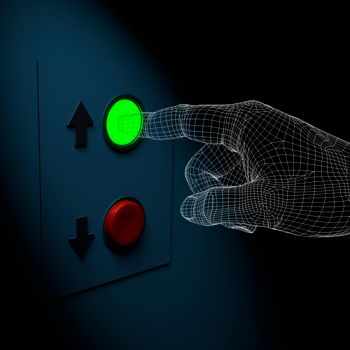A magazine where the digital world meets the real world.
On the web
- Home
- Browse by date
- Browse by topic
- Enter the maze
- Follow our blog
- Follow us on Twitter
- Resources for teachers
- Subscribe
In print
What is cs4fn?
- About us
- Contact us
- Partners
- Privacy and cookies
- Copyright and contributions
- Links to other fun sites
- Complete our questionnaire, give us feedback
Search:
Lift me up!

"Reset mode engaged. Five. Four. Three...".
Boston, April 2012. The lift is taking its time to get to the floor, but waiting here near this large window over the city is not a problem at all. The cityscape from the 23rd floor can be impressive. The sky looks closer, the blue is transparent, the city streets long and silent.
"Bing-bong, 23rd floor, doors opening."
Basement (I press the button - click!).
"Doors closing. Lift going down."
A stylish display reels the floor numbers off as the lift moves towards the basement. The main panel has 24 independent digits plus levels PH, M, L, B. A lower panel has a card reader and another group of buttons: alarm, stop, emergency phone and... reset? I wonder what the reset button is for. Maybe better not explore! If I were to design a time capsule, it would look similar to this lift. Maybe with a comfortable seat.
"Bing-bong, basement."
Finally, time to go... if the lift ever decides to open the doors.
Basement (click!) Nothing.
First floor, Second floor. Nothing.
How many things can you possibly do to a lift? Press a button to select a floor, and the lift is supposed to take you there. And this lift is clearly refusing to do anything. Maybe I need to use my room card to get access to the floor?
"Card accepted, select floor".
Basement --- click! Nothing. The lift doesn't move. Let's try another floor.
First, second (click! click!)... Nothing.
I can't believe it, I'm stuck! Tricked by a lift. This is rather embarrassing given I’m a computer scientist. Time to ring them.
(click!)
"Reset mode engaged."
Oh boy, this is really not my day! I just pressed the reset button by mistake (what is it for anyway?) --- it was next to the emergency button!
(click! click! click! click! - I’m desperately pushing things at random now)
"Lounge." Woohoo, I'm getting somewhere!
"Doors opening." I’m able to get out of the lift, finally, with a smile as big as the moon!
Soon afterwards I discover that others had been trapped in the lift when selecting the basement too. That floor was, in fact, closed for renovation. The lift was re-programmed so that any request to get to the basement would actually take you to the lounge --- which is why the doors opened as soon as I pushed the "L" button. Whoever re-programmed the lift didn’t think to give feedback, with the consequence that its behaviour became unpredictable to the people using it.
Human-computer interaction (HCI) researchers study these types of problems. They call them "automation surprises", patterns hidden in the design of a device that lead to it acting in unexpected ways. They happen when the person using the gadget loses track of what it thinks it’s doing. If used cleverly, automation surprises can give a richer experience in games. They are better avoided in other situations though. After all can you imagine the consequences of a pilot pressing a ‘reset’ button on an aircraft cockpit by mistake?


